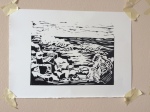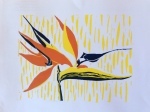28/09/16
Assignment 2: First Relief Prints
Submissions:
Task 1 (Project 5):
- First attempt at pulling a print – the result was a little messy.
- Second attempt at the print – cleaner and crisper generally.
Two printed test cuts (mark making).
Task 2 (Project 6):
- Montana Roja A4 newsprint
- Montana Roja A4 Off-white Printing Paper
- Montana Roja A4 Bright White Cartridge Paper
Three single colour linocut prints
- Coastal scene – selected final print on heavy weight, off-white A4 cartridge paper.
- Villa – selected final print on A4 bright white light weight cartridge paper
Other single colour linocuts
Task 3 (Project 7):
- Assignment 2 Project 7 Print 1
- Assignment 2 Project 7 Print 2
- Assignment 2 Project 7 Print 3
Three multi-block prints
- Assignment 2 Project 7 Print of Block 1
- Assignment 2 Project 7 Print of Block 2
- Assignment 2 Project 7 Print of Block 3
One impression in a single colour of individual lino blocks
In Addition
To support your work you will have drawings, comments and ideas for further experiments in your learning log.
I have been exploring concepts and ideas with meaning and an emotional connection to me. I have considered contrasts as a subject, which has been explored in page 19 of my sketchbook, and also a subject that strikes me often in everyday life and news, misogyny by other women. I have encountered this first hand throughout life and it never fails to surprise and disappoint me – from school days when apparent friends discuss others’ faults behind their backs, to the workplace (particularly in male dominated environments) where a female manager saw others as a threat, to mothers judging childless women as lesser emotional beings. These occasions are frequent, however, they are dealt with by conflict or taking the higher ground as appropriate. It is particularly prevalent in today’s society, where social media (a misnomer if ever I heard one – more anti-social), is used by anonymous keyboard warriors to spill their vitriolic opinions. However, I am interested in exploring why this is the case. During my brain storming, it transpired that the latter example was the one that meant the most to me. It is a personal journey that I am beginning and may be cause some offence and indignation to some, however, that is exactly how I have felt on many occasions being the recipient of such judgement.
How can this be brought into my artwork? That is a very good question, and is probably why I have not tackled the conceptual element of art so far. However, working through my thoughts and feelings in my sketchbook is beginning to forge a path through the minefield (pages 19, 27-29). I have come to the conclusion that it is best tackled in a series of images and considering that this is a printing course, the use of symbols is a good place to start. I am also exploring the use of text within an image. I concede that these are not original elements, however, I am hoping that they will put across the message. The message that everyone has their story and is entitled to their privacy and not to be judged unfairly or cruelly.

Concepts and Ideas for Further Experiments
“Contrasts & Female Misogyny” Mothers – Childless – Totem Pole Designs
REFLECTION AGAINST ASSESSMENT CRITERIA
Demonstration of Technical & Visual Skills
Materials:
This was a big learning curve, from the Soft Cut to authentic lino, water-based to oil-based inks and different types of paper. I have discovered a preference for authentic lino and oil-based inks, types of paper will be an ongoing experiment and often depends on the outcome of the proof print.
Techniques:
Learning which type of cutting tools to use for the desired effect will be ongoing. I was particularly held back when cutting away larger areas that I didn’t want printed until I thought about using the square ended tool. The registering of the paper and block successfully is crucial to a clean print, particularly when using multi-blocks. I had some success with both methods, by eye and using a jig, however, as noted in my write-up, the jig method gave me more confidence. The multi-block linoprints were a lot of work, however, they are versatile in that I could make the required change to the first block, which I wouldn’t have been able to do with the reductive technique (not that I’ve tried it yet).
Observational Skills:
Looking for suitable subjects appropriate to single colour and multi-block techniques, and to my current skill level was sometimes difficult. Composition is still key and I drew on previous courses to consider fore, mid and background, the rule of thirds, using the frame to fill the space, playing with scale etc.
Quality of Outcome
The single colour linoprints were of variable quality due to the subject and materials chosen plus obviously, skill level. My favourite composition for the single linoprint was of Montana Roja, even though I forgot to reverse the transfer! I still feel it has impact and am pleased with the marks replicating the light and dark, texture, scale and perspective elements. I would like to try this subject again, the right way round, in the future. Regarding the multi-colour linoprint, I am relatively pleased with the result for a first ever attempt. However, I can see may improvements to develop:
- Use genuine lino for the block to increase crispness of cut
- Be more adventurous regarding the detail marks as was begun in the flower bud/sheath.
- Introduce outline where appropriate
Application of Knowledge:
I think this played a big part in my subject choices. Previous courses in drawing and painting influenced how I structured my compositions as note above.
Presentation:
This improved throughout the projects. Initially the test prints were a little messy on the edges. As I progressed I was more aware of superfluous marks and smudges and tried to eradicate them prior to actually printing the image. I haven’t addressed the subject of editioning as yet because I haven’t had a long print run – although I have taken on board the theory.
Discernment:
This is improving, which is probably why I stalled for so long during Project 7. I felt that the initial composition wasn’t right for several reasons and it was not until I found my subject by accident that I was happy to continue. Selecting the most successful prints is becoming easier too. I am extremely self-critical and will continue to be so, however, I have to accept that I am learning and “mistakes” are a crucial part of that process. Sometimes “mistakes” are actually more exciting as I noticed in the first multi-block print where the orange infiltrated the background. Had it not also contaminated the actual flower,I would have preferred it to the attempt at “perfection”. Perfection, whatever that is, is becoming more monotonous to me.
Conceptualisation of Thoughts:
This is still in its infancy – I have concentrated on learning the techniques so far. However, I am being encouraged to attack this more confidently by my tutor. I have begun to formulate an idea to take forward. this is being explored in my sketchbook. I need to consider symbolism, the message and the image itself and I am now excited to push this further.
Demonstration of Creativity
Imagination:
My main learning process so far has been from life – trying to attain proportion, accuracy, perspective etc. All are invaluable aspects and skills, however, I feel at the expense of my intuition, imagination and creativity. The exploration of my embryonic conceptual idea is going to push this forward and I am feeling more confident that I can explore more deeply into my own feelings.
I enjoy experimenting with different media and effects and I think this will help me with bringing out my imagination and creativity. I feel that I can often see the unusual in the ordinary and trying to reproduce this vision is what is going to aid me with fulfilling this criteria.
Context
This is a skill in itself. I am now more questioning, observant and critical when researching and viewing other artists’ work. I look deeper, not just at the technical aspects, but for what is being said and why. I am more intrigued with the ambiguous and expressive. I would rather return to such works many times and still come away with questions as well as answers. I feel art should make the viewer work to fully appreciate it. That is a tall order to give myself, I realise.
















